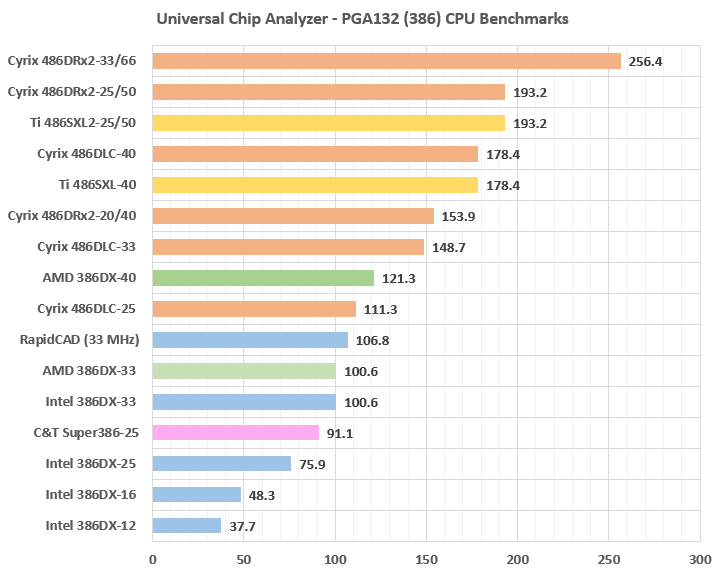The C&T Super386 being the last of the PGA 386-compatible CPUs ever released to be supported by the Universal Chip Analyzer, it was time to publish some benchmarks! The current integrated benchmark uses a lot of standard x86 operations (mov, add, conditional and unconditional jumps, …) and integer math instructions (add, sub, div, mult). Keep in mind that the UCA can achieve a 0-wait-states-everywhere communication with the CPU, nullifying any added latencies from chipset, RAM, or whatever. The results below are 100% linked to the raw CPU power without any limitation from the subsystem.
 First, all 386 compatibles manufacturers which claimed superior performance versus Intel’s 386 actually delivered their promises. AMD’s 386s use the exact same die and consequently offers the same performance. Intel’s own RapidCAD is only 6% faster than the standard 386 on integer operation but comes with an integrated FPU offering much higher speed on floating point operations. The C&T Super386 is significantly faster than Intel’s 386: about 20% higher. C&T claimed its microprocessors were up to 10 percent more powerful than Intel’s, which looks almost correct in real-world applications where added latencies from buses and memory lower the raw gain.
First, all 386 compatibles manufacturers which claimed superior performance versus Intel’s 386 actually delivered their promises. AMD’s 386s use the exact same die and consequently offers the same performance. Intel’s own RapidCAD is only 6% faster than the standard 386 on integer operation but comes with an integrated FPU offering much higher speed on floating point operations. The C&T Super386 is significantly faster than Intel’s 386: about 20% higher. C&T claimed its microprocessors were up to 10 percent more powerful than Intel’s, which looks almost correct in real-world applications where added latencies from buses and memory lower the raw gain.
Anyway, the much more advanced Cyrix 486 Core (and its licensed clone from Texas Instrument) takes the lead by a giant margin despite being pin-compatible with the 386 Socket. The slowest Cyrix 486DLC-25 is almost as fast as an Intel/AMD 386 clocked 40 MHz, and the clock-doubled 486DRx2 are twice faster than the fastest Intel 386!
Stay tuned for bigger UCA news tomorrow!


Keep up the great work!
Looking forward to when the UCA is available 🙂
UCA and this overview are great!
Do you plan to make a similar benchmark post for the 486-bus CPUs?
And eventually also for the other CPUs supported by UCA.
Absolutely!
Can you also try enabling CPUID via CCR4 for the Cyrix 5×86 (stepping 1) and DX4 (especially the 120MHz sample)?
Showing the whole CPUID dump would be interesting (e.g. 01h EDX).
Can UCA work with NexGen CPUs/FPUs?
Whole CPUID is already dumped by the UCA. More interesting, JTAG CPUID is also read. I’m currently working on 486 shield software.
About Nexgen, they use 64-bit bus which is outside of the capabilities of the UCA (not enough pin)
There is another 386 chip – ALi M1386SX http://web.archive.org/web/19980504194728/www.ali.com.tw/eframep.htm
More common in its versions with integrated chipset – M6117
Unfortunately not available as PGA or even with a PGA adapter. Maybe an opportunity to design one?